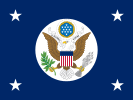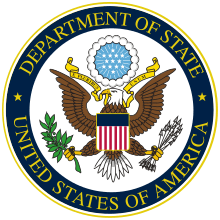United States Secretary of State
The secretary of state is the head of the United States Department of State which is concerned with foreign affairs and is a member of the Cabinet of the United States. The secretary of state is analogous to a foreign minister in other countries.[3][4]
| United States Secretary of State | |
|---|---|
 Seal of the Secretary of State | |
 Flag of the Secretary of State | |
| United States Department of State | |
| Style | Mr. Secretary The Honorable |
| Member of | Cabinet National Security Council |
| Reports to | President of the United States |
| Seat | Washington, D.C. |
| Appointer | The President with Senate advice and consent |
| Constituting instrument | 22 U.S.C. § 2651 |
| Precursor | Secretary of Foreign Affairs |
| Formation | July 27, 1789 |
| First holder | Thomas Jefferson |
| Succession | Fourth[1] |
| Deputy | Deputy Secretary of State |
| Salary | Executive Schedule, level I[2] |
| Website | www.state.gov |
The secretary of state is nominated by the president of the United States and, following a confirmation hearing before the Senate Committee on Foreign Relations, is confirmed by the United States Senate. The secretary of state, along with the secretary of the treasury, secretary of defense, and attorney general, are generally regarded as the four most important Cabinet members because of the importance of their respective departments.[5] Secretary of State is a Level I position in the Executive Schedule and thus earns the salary prescribed for that level (currently US$210,700).[2]
The current secretary of state is Mike Pompeo, who has served as Secretary of State in the administration of President Donald Trump since early 2018.
Duties and responsibilities
The stated duties of the secretary of state are to supervise the United States foreign service, immigration policy, and administer the Department of State. They must also advise the president on U.S. foreign matters such as the appointment of diplomats and ambassadors. They also advise the president of the dismissal and recall of these individuals. The secretary of state can conduct negotiations, interpret, and terminate treaties relating to foreign policy. They also can participate in international conferences, organizations and agencies as a representative of the United States. The secretary of state communicates issues relating to the U.S. foreign policy to Congress and U.S. citizens. They also provide services to U.S. citizens living or traveling abroad such as providing credentials in the form of passports. Doing this, they also ensure the protection of U.S. citizens themselves, their property, and interests in foreign countries.[6]
Secretaries of state also have domestic responsibilities, entrusted in 1789, when the position was first created. These include the protection and custody of the Great Seal of the United States, and the preparation of some presidential proclamations. In the process of extraditing fugitives to or from the U.S., the secretary serves as the channel of communication between foreign governments and the federal government and the states.[6]
Most of the domestic functions of the Department of State have been transferred to other agencies. Those that remain include storage and use of the Great Seal of the United States, performance of protocol functions for the White House, and the drafting of certain proclamations. The secretary also negotiates with the individual States over the extradition of fugitives to foreign countries.[7] Under Federal Law,[8] the resignation of a president or of a vice president is only valid if declared in writing, in an instrument delivered to the office of the secretary of state. Accordingly, the resignations of President Richard Nixon and of Vice President Spiro Agnew were formalized in instruments delivered to Secretary of State Henry Kissinger.
As the highest-ranking member of the cabinet, the secretary of state is the third-highest official of the executive branch of the federal government of the United States, after the president and vice president, and is fourth in line to succeed the presidency, coming after the vice president, the speaker of the House of Representatives, and the president pro tempore of the Senate. Six secretaries of state -- Jefferson, Madison, Monroe, John Quincy Adams, Van Buren and Buchanan -- have gone on to be elected president. Others, including Henry Clay, William Seward, James Blaine, William Jennings Bryan, John Kerry, and Hillary Clinton have been unsuccessful presidential candidates, either before or after their term of office as Secretary of State.
The nature of the position means that secretaries of state engage in travel around the world. The record for most countries visited in a secretary's tenure is 112 by Hillary Clinton.[9] Second is Madeleine Albright with 96.[10] The record for most air miles traveled in a secretary's tenure is 1,417,576 miles by John Kerry.[11] Second is Condoleezza Rice's 1,059,247 miles,[12] and third is Clinton's 956,733 miles.[13]
References
- "3 U.S. Code § 19 - Vacancy in offices of both President and Vice President; officers eligible to act". Cornell Law School.
- 5 U.S.C. § 5312.
- "Heads of State, Heads of Government, Ministers for Foreign Affairs", Protocol and Liaison Service, United Nations. Retrieved November 2, 2012.
- NATO Member Countries, NATO. Retrieved November 2, 2012.
- "Cabinets and Counselors: The President and the Executive Branch" (1997). Congressional Quarterly. p. 87.
- "Duties of the Secretary of State". U.S. Department of State. Retrieved February 1, 2017.
- "Duties of the Secretary of State of the United States". www.state.gov. United States Department of State. January 20, 2009. Retrieved March 28, 2010.
- "3 U.S. Code § 20 - Resignation or refusal of office".
- Mark Landler (January 4, 2013). "Scare Adds to Fears That Clinton's Work Has Taken Toll". The New York Times.
- Lee, Matthew (June 28, 2012). "Frequent flier Hillary Clinton hits 100-country mark". Detroit Free Press. Associated Press. Archived from the original on June 28, 2012.
- https://2009-2017.state.gov/secretary/travel/index.htm
- https://2001-2009.state.gov/secretary/trvl/index.htm
- https://2009-2017.state.gov/secretary/20092013clinton/trvl/264084.htm
- Ford, Worthington C., ed. (1927). Statesman and Friend: Correspondence of John Adams with Benjamin Waterhouse, 1784–1822. Boston, MA: Little, Brown, and Company. p. 57.
Further reading
- Bemis, Samuel Flagg, ed. The American secretaries of state and their diplomacy (19 vol., 1963( scholarly biographies.
- Graebner, Norman A., ed. An Uncertain Tradition: American Secretaries of State in the Twentieth Century (1961) scholarly essays on John Hay through John Foster Dulles.
- Hopkins, Michael F. "President Harry Truman's Secretaries of State: Stettinius, Byrnes, Marshall and Acheson." Journal of Transatlantic Studies 6.3 (2008): 290-304.
- Mihalkanin Edward, ed. American Statesmen: Secretaries of State from John Jay to Colin Powell (2004); short scholarly articles by experts; 572pp online
External links
| Wikimedia Commons has media related to Secretaries of State of the United States. |
| Wikiquote has quotations related to: United States Secretary of State |
| U.S. order of precedence (ceremonial) | ||
|---|---|---|
| Preceded by Ambassadors from the United States (while at their posts) |
Order of Precedence of the United States as Secretary of State |
Succeeded by Ambassadors to the United States (in order of tenure) |
| Preceded by Otherwise Barack Obama as Former President |
Succeeded by Otherwise António Guterres as Secretary-General of the United Nations | |
| U.S. presidential line of succession | ||
| Preceded by President pro tempore of the Senate Charles Grassley |
4th in line | Succeeded by Secretary of the Treasury Steve Mnuchin |
.jpg)
